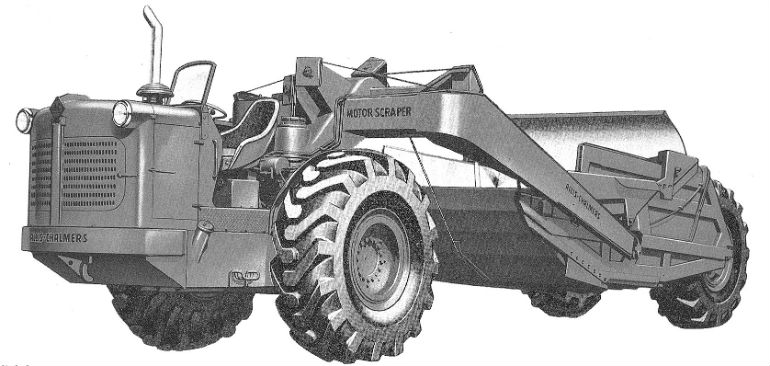The TS-300 was not an original Allis-Chalmers designed machine. Following WWII, the LaPlant-Choate Manufacturing Company of Cedar Rapids, Iowa, a long time builder of dozer blades, rippers and towed scrapers, wished to follow competitor Le Tourneau’s example and build a self propelled scraper. The prototype was ready for testing by mid 1945 and put into full scale production in 1947.
LaPlant-Choate was already a well respected name in earthmoving circles and supplied a good deal of its equipment to Caterpillar for use with their track-type tractors. LaPlant-Choate was also one of the pioneers in the field of hydraulics, as applied to earthmoving equipment, and had established a good measure of reliability with this type of methodology.
It is not a very well known fact that many of the hydraulically operated earthmoving machines of today are based on principles established by LaPlant-Chaote before WWII.
The TS-300 “motor scraper” (also a term coined by LaPlant-Choate) was well received when it entered service.
Powerplant could be either a 275hp Cummins model NHS600 or a 280hp Buda model 6DAS-844 depending on the customer’s preference. The Buda, however, appears to be the favoured engine fitted. This was connected, via a 17 inch dry clutch, to a Fuller four-speed manual transmission. Fully loaded the TS-300 could move along at 23 miles per hour.
Where the TS-300 differed from its contemporaries was in its steering, which was fully hydraulic and capable of 90 degree turns in either direction. By comparison, LeTourneau’s model C Tournapull was clutch and brake steered, and Heil’s ‘Heil-Liner’, while also hydraulically steered, could only manage 70 degree turns – Euclid and Caterpillar had yet to make an appearance in the two-axle overhung scraper market of 1947.
The 14 cubic-yard struck, all cable controlled scraper was of relatively conventional design and featured a curved cutting edge – another LaPlant-Choate trademark – in order to obtain heaped loads faster and with less effort on the machine.
An unusual design, that carried over well into the Allis-Chalmers period, was the apron, which was linked to the ejector so that as the ejector came forward the apron was always at maximum lift in order to dislodge loads quickly and cleanly.
A respectably sized push block finished off the rear of the scraper and presented an easy target for push tractor operators.
LaPlant-Choate also offered a 19 cubic yard bottom dump for use with the TS-300 tractor.
In this configuration the machine was known as a TW-300 (W for wagon).
These kind of rigs were very popular in the USA in the 1950s with just about all the major manufacturers offering matching bottom dump wagons to go with their scraper tractors.
As far as the operator was concerned, there was not a great deal to commend the TS-300 as there was very little in the way of creature comforts and the engine was partially exposed to his right with all the heat and noise that this entailed. Even the seat was rigidly mounted to the frame.
Adding to his discomfort was the fact that the cables that raised and lowered the bowl passed disturbingly close to the back of his head along the machines draft arm – a cable breakage at this point would result it a whiplash effect that could easily decapitate an operator.
All was not entirely doom and gloom, however, as the scraper controls featured air boosters to lessen arm movement stresses and the hydraulic steering would have been well appreciated by those operators transitioning from Le Tourneau’s scrapers.
Allis-Chalmers had been wishing to enter the motor scraper arena to complete their product range and, rather than spend the millions of dollars it would have taken (even in those days) to develop their own range of machines, a buy out of the cash strapped LaPlant-Choate was proposed and carried out in 1952.
Existing LaPlant-Choate product was painted Persian Orange and re-labelled Allis-Chalmers.
The following year Allis-Chalmers also bought the Buda Engine Co making them (Allis-Chalmers) the only manufacturer of earthmoving equipment in the USA, besides Caterpillar, to offer a full range of machines and engines.
Although the TS-300 remained in the Allis-Chalmers catalogue from 1952 until 1955, very few improvements or modifications were made to the machine other than an increase in heaped capacity, which was achieved by sideboarding, and the deletion of the optional Cummins engine. After all, Allis-Chalmers were by now churning out hundreds of AC-badged Buda engines.
The TS-300 was replaced by the model TS-360 in late 1955. Interestingly, the TS-360, apart from a redesigned tractor unit, utilised an almost unchanged TS-300 bowl.
The New Zealand Connection
Downer & Company remain the only users of the TS-300 in New Zealand and all of their machines were from Allis-Chalmers’ production of the type.
Although some were imported with scrapers, they were mainly used as prime movers for Yuba Manufacturing Co’s Movall forced-ejection body dumpers at the Kimihia and latterly Weavers Crossing opencast mines before their retirement.
It is highly unlikely that any have survived and the author is not aware of any surviving overseas examples either, which is a pity.
Brief Specifications – Allis-Chalmers TS-300
Engine: Buda 6-DAS-844, six-cylinder, supercharged, 280 hp
Clutch: 17” single dry plate Lipe-Rollway
Transmission: Fuller 4 A112 manual, four speed forward, one reverse.
Top Speed: 23 mph
Brakes: Expanding shoe type, air operated
Steering: Full hydraulic, 90 degrees each way
Turning Circle: 31’6”
Std.Tyre: 24.00 x 29 on all axles
Cable Control: Allis-Chalmers double drum
Capacity: 14yd³ struck, 18 cubic yards heaped
Length: 37’ 6”
Width: 11’ 6”
Height: 10’ 6”
Operating Weight: 21.4 tons (empty)

